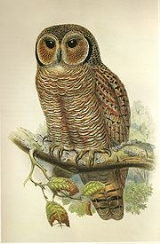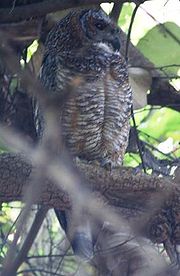
Mottled Wood Owl
Encyclopedia
The Mottled Wood Owl is a species of large owl
found in India
. They are found in gardens and thin deciduous forests adjacent to dry thorn forests or farmland. They are easily detected by their distinctive tremulous eerie calls at dawn and dusk. The characteristic call is a duet of the male and female while other notes include a low hoot and a screech. Their large size, lack of "ear" tufts and the concentric barring on the face make them easy to identify.
 This large owl lacks ear tufts and is mottled and vermiculated in reddish brown and white. The face disc is marked with fine concentric black and white barring. The sexes are alike. The chin is white. The eyelid is orange and the iris is dark brown. The tail is barred narrowly in brown and black. The concentric barring on the face and mottled crown separate it from the Brown Wood Owl
This large owl lacks ear tufts and is mottled and vermiculated in reddish brown and white. The face disc is marked with fine concentric black and white barring. The sexes are alike. The chin is white. The eyelid is orange and the iris is dark brown. The tail is barred narrowly in brown and black. The concentric barring on the face and mottled crown separate it from the Brown Wood Owl
in southern India.
There are three subspecies recognized and there are no sharp demarcations in their distributions.
, mice and other small mammals.
Owl
Owls are a group of birds that belong to the order Strigiformes, constituting 200 bird of prey species. Most are solitary and nocturnal, with some exceptions . Owls hunt mostly small mammals, insects, and other birds, although a few species specialize in hunting fish...
found in India
India
India , officially the Republic of India , is a country in South Asia. It is the seventh-largest country by geographical area, the second-most populous country with over 1.2 billion people, and the most populous democracy in the world...
. They are found in gardens and thin deciduous forests adjacent to dry thorn forests or farmland. They are easily detected by their distinctive tremulous eerie calls at dawn and dusk. The characteristic call is a duet of the male and female while other notes include a low hoot and a screech. Their large size, lack of "ear" tufts and the concentric barring on the face make them easy to identify.
Description

Brown Wood Owl
The Brown Wood Owl, Strix leptogrammica, is an owl which is a resident breeder in south Asia from India and Sri Lanka east to western Indonesia and south China. This species is a part of the family of owls known as typical owls , which contains most species of owl...
in southern India.
There are three subspecies recognized and there are no sharp demarcations in their distributions.
- S. o. ocellata (Lesson, 1839) is found in southern India and is shorter winged in the males (333–338 mm) than grandis
- S. o. grisescens Koelz, 1950 is found in northern India south of the Himalayas, west to Pakistan and east to Bihar. The markings are pale above and the males have a wing length of 338–346 mm
- S. o. grandis Koelz, 1950 from Gujarat is differentiated by the wing length of the males (360–372 mm)
Distribution and habitat
The species is found in the plains in gardens and lightly wooded habitats. They roost in trees during the day choosing a branch with dense foliage. An old specimen from Lahore is noted but no records in recent times from Pakistan. The distribution extends east to West Bengal.Behaviour and ecology
These owls roost in the day, usually in pairs. When disturbed they may fly in bright sunshine although they choose to shelter within a dense grove of trees. They produce an eerie chuhua-aa call with a quaver in the second note. This call is an antiphonal duet of the male and female. The male calls one or two times followed by the female's shorter and less tremulous version. The calling is more frequent in November when the begin to breed. Most Nests are found from February to April. They also produce a single note hoot and a screech not unlike that of the Barn Owl. The nest is a tree hollow in which two to 3 white eggs are laid. They feed on palm squirrelsFunambulus
Funambulus is a genus of rodent in the Sciuridae family.It contains the following species:* Genus Funambulus** Subgenus Funambulus*** Layard's Palm Squirrel *** Indian Palm Squirrel...
, mice and other small mammals.

